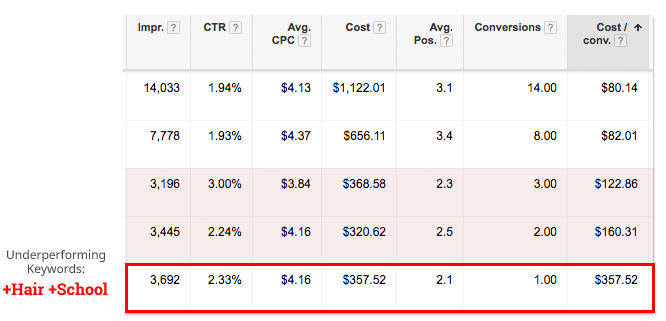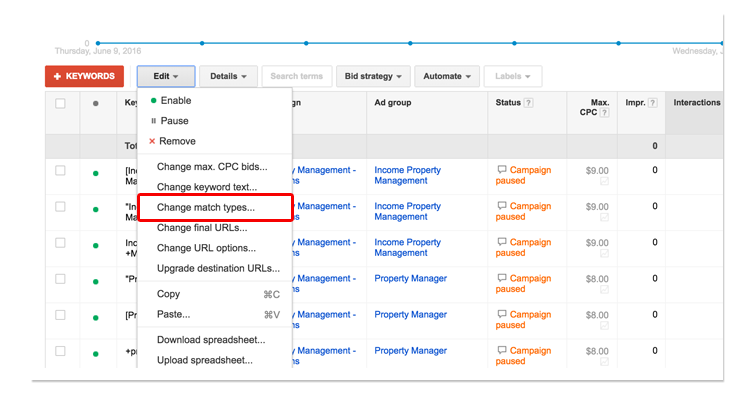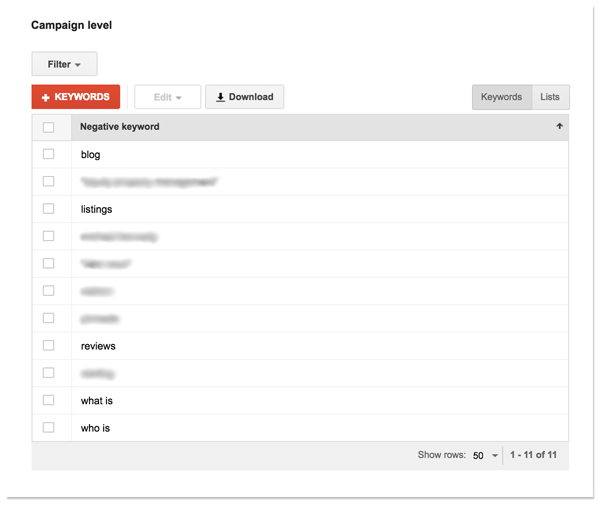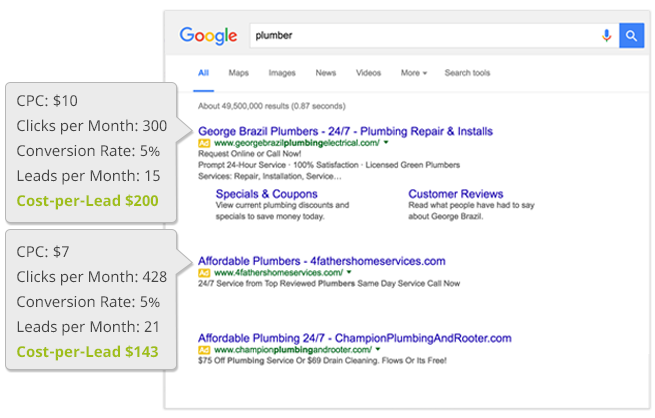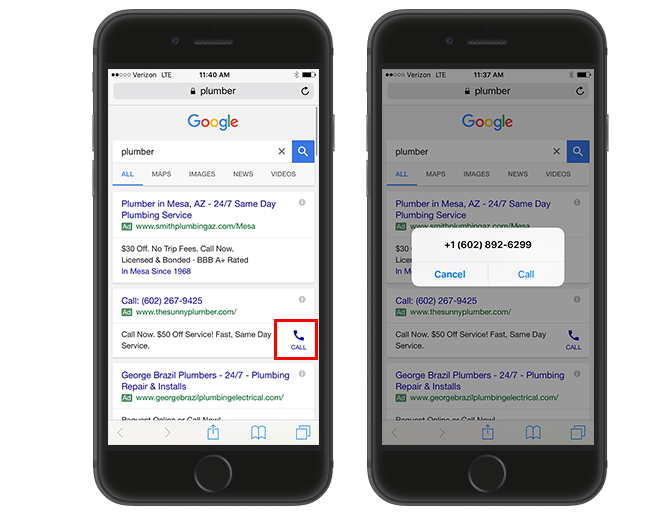Struggling to reduce your AdWords spend?
While Google ads can bring a ton of qualified leads to your business, your budget can quickly run out if you aren’t paying attention or optimizing your campaigns.
Here are 5 of our go-to methods for cutting down on AdWords costs.
1. Analyze the cost-per-conversion of each keyword
Let’s start with the easy stuff.
How much does each conversion cost? You might have some keywords with a $50 cost-per-conversion, and others that are $150.
To reduce your AdWords spend quickly, pause or lower the bid amount for the keywords with the highest costs-per-conversion. One of the most common reasons for a high cost is that the keyword isn’t as relevant to the user’s search, so there’s a lower likelihood for conversion.
Whether the cost-per-conversion is high because of keyword relevancy or something else, you’re better off investing your resources into the keywords that are already generating better results at a lower bid.
2. Stop using broad match
We’ve talked before about the different AdWords keyword match types, but the general gist is this: When setting up a Google AdWords campaign, you’ll have the option to choose a match type.
The automatic setting is “broad match.”
Change this to modified broad match, phrase match, or exact match. Pronto.
Broad match means your ad will show for any search that Google thinks is related to your keyword.
For example, let’s say you run a dental practice, and your campaign targets the keyword “professional teeth whitening” to promote your teeth whitening service. However, when your match type is set on broad match, your ad may show for a search like “whiten teeth at home.”
While this is vaguely related, the searcher is looking for a cheap way to whiten their teeth at home, not visit a dentist for professional treatment. Your ad wouldn’t show for that search with modified broad or phrase matching.
Targeted ads using the right match types can help you connect with people who are actively seeking expert dental care—those looking for real results and long-term solutions.
For example, someone specifically searching for invisalign henderson nv is likely ready to take that next step toward a straighter smile with the guidance of a trusted professional. They’re not browsing casual tips—they’re seeking care from a skilled provider who can walk them through every stage of their smile transformation.
To avoid wasting budget on keywords that won’t lead to conversions, use modified broad match or exact match. It’ll automatically give you more control over when your ads show and ensure the searchers who see them are more likely to want your product or service.
That same level of intention you bring to your marketing should carry through to the patient experience. Once those targeted ads have done their job, it’s your dental service that turns curiosity into confidence—and first-time visitors into lifelong patients.
Modern dental care is more than cleanings and checkups; it’s about crafting a personalized, comfortable experience that makes people feel genuinely cared for. Whether someone is coming in for their first whitening session or finally ready to explore veneers, a seasoned dentist in st george utah can provide expert guidance and treatment with a human touch that no over-the-counter kit can replicate.
From preventive care to full smile makeovers, every step of the patient journey should reflect professionalism, warmth, and a dedication to long-term results. People want to know they’re not just another appointment on the calendar—they’re a smile worth investing in. And that’s where your practice can shine, delivering care that matches the quality promised in your ads.
3. Add negative keywords
Just as keywords make your ad show to anyone searching for a given term, negative keywords hide the ad from someone’s who searching for a certain term.
Why would you want to hide your ads? Let’s revisit the dentist example. Say you’re bidding on the keyword “professional teeth whitening,” but you see that your ad is showing for people who are searching for “professional teeth whitening kits for home.”
Just like we discussed before, the user is specifically looking for ways to whiten their teeth at home, and they probably aren’t interested in going to a dentist. In this case, add “home” and “kits” as negative keywords to stop your ad from displaying when those terms are in the search query, which will help avoid paying for clicks from users who aren’t likely to convert.
Adding negative keywords to your AdWords campaign is an effective way to cut costs by removing wasted clicks. However, choose your negative keywords carefully so you don’t lose impressions from users who may be interested in your business.
4. Go for the second ad position
Believe it or not, you don’t always need to have the #1 ad position on Google. In fact, aiming for a position that is a little further down the page can trim your ad spend, while still attracting the leads you want.
Read our article about this, and then experiment with your own campaigns. You may find that slightly reducing your ad position results in a better ROI.
5. Optimize for mobile
If many of your users are landing on your website via a phone or tablet, optimizing your ads to be mobile-friendly helps provide a better experience, increase conversions, and even reduce your costs. Here are a few key ways to optimize for mobile.
First, make sure the landing page your AdWords campaign links to is mobile friendly. This means it’s responsive, doesn’t have excessive images or functionality that slows down loading time, and uses fonts and high-contrast colors that are easy to see, even in bright sunlight.
Also, make sure phone numbers are click-to-call so a visitor can easily reach your business without having to memorize your phone number.
Call extensions
The next piece to make sure you’re using is call extensions, which display your phone number right within the ad. Many phone providers allow users to click the phone number and call you directly, rather than typing it in. (Bonus points: Track those phone calls!)
Mobile-specific ads
If you’re getting a lot of traffic from mobile devices, consider running ads designed specifically for mobile searchers. When creating mobile ads, use short keywords in the text, and emphasize any special promotions first. Callout extensions are especially good in this case, as they’ll allow users to see your specials listed right in the ad.
Call-only ads
While mobile-specific ads are traditional ads customized for mobile devices, call-only ads immediately call your business when someone clicks the ad. The customer never see a landing page. Instead, the phone dialer appears with your phone number and they’re immediately connected to you.
Want to reduce your AdWords spend?
ParaCore has helped businesses in a variety of industries decrease the cost of their AdWords campaigns and bring in leads to grow their business. Curious how we could do the same for you? Get a free AdWords analysis here.
Related Posts
- What Is The Difference Between PPC and SEM?
- PC Audit Handbook: How to Analyze Your PPC Campaigns
- The Best PPC Tools of 2022, As Told by PPC Experts
- Beginner’s Guide to UTM Tags & Tracking
- Generate Leads with Facebook Lead Ads
- Cost-per-click vs. cost-per-acquisition: Are you tracking the right PPC metrics?
- How Does Pay Per Click Work?
- Benefits of PPC
- Why Should I Invest in PPC?
- What is Google PPC Advertising?
- Facebook Retargeting Strategy
- Introduction to ManyChat
- Case Study: Return on Ad Spend Optimization
- 🎁🎄 Holiday Ad Spend Strategy
- Should You Be Running Branded Ads?
- SEO vs SEM
- CTAs for YouTube Ads
- Case Study: 258% Increase in Conversions
- Traffic Campaign Strategy
- No Captions on Facebook Ads or YouTube? You’re Killing Performance
- LinkedIn InMail Website Re-targeting
